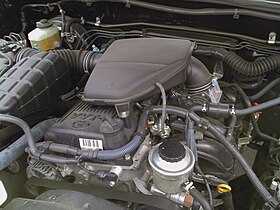Toyota TR engine
| Toyota TR engine | |
|---|---|
 2TR-FE engine | |
| Overview | |
| Manufacturer | Toyota Motor Corporation |
| Production | 2003–present |
| Layout | |
| Configuration | Naturally aspirated Straight-4 |
| Combustion | |
| Fuel system | Fuel injection |
| Fuel type | Gasoline |
| Cooling system | Water-cooled |
| Output | |
| Power output | 85–120 kW (114–161 hp; 116–163 PS) |
| Torque output | 18.6–25.1 kg⋅m (182–246 N⋅m; 135–182 lbf⋅ft) |
| Chronology | |
| Predecessor | Toyota RZ engine |
This article needs additional citations for verification. (December 2009) |
The Toyota TR engine is a family of gasoline engines that appeared in 2004. They are mainly used for Toyota Hilux and other vehicles in the Toyota IMV platform; and are designed to be mounted longitudinally for pickup RWD and 4WD pickup applications.
1TR-FE[edit]

The 1TR-FE is a 2.0 L (1,998 cc) Straight-4 gasoline engine. It features DOHC, 16 valves and VVT-i. Bore and stroke is 86 mm × 86 mm (3.39 in × 3.39 in). Its power is 100 kW (134 hp; 136 PS) at 5,600 rpm, and 18.6 kg⋅m (182 N⋅m; 135 lbf⋅ft) of torque at 4,000 rpm with redline of 6000 rpm.
Just like its sister, the 2TR-FE engine, the 1TR-FE engine also received a Dual VVT-i update. The updated power is 102 kW (137 hp; 139 PS) at 5,600 rpm.
- Applications
- Toyota Dyna Y200 (2003–present)
- Toyota HiAce H100/200 (2003–present)
- Toyota RegiusAce H100/200 (2003–2020)
- Toyota ToyoAce Y200 (2003–2020)
- Toyota Innova AN40/140 (2004–2022)
- Toyota Hilux AN10/110 (2004–present)
- Toyota Comfort TSS13Y (2007–2009, 2011–2017)
- Toyota Hilux Champ (2023–present)
- Hino Dutro
- Mazda Bongo Brawny H200 (2019–present)
1TR-FPE[edit]
The 1TR-FPE is an LPG version of the 1TR-FE engine. Its power is 85 kW (114 hp; 116 PS) at 4,800 rpm and torque is 19.3 kg⋅m (189 N⋅m; 140 lbf⋅ft) at 3,700 rpm. The compression ratio is 10.6:1. Bore and stroke is 86 mm × 86 mm (3.39 in × 3.39 in).[1]
- Applications
- Toyota Dyna Y200 (2003–2022)
- Toyota ToyoAce Y200 (2003–2020)
- Toyota Comfort TSS11Y (2007–2009, 2011–2017)
- Hino Dutro
2TR-FE[edit]
The 2TR-FE is a 2.7 L (2,693 cc) Straight-4 gasoline engine. It features DOHC, 16 valves and VVT-i. Maximum power is 118 kW (158 hp; 160 PS) at 5,200 rpm, and 25.1 kg⋅m (246 N⋅m; 182 lbf⋅ft) of torque at 3,800 rpm with redline of 5500 rpm. The bore and stroke are 95 mm × 95 mm (3.74 in × 3.74 in). The compression ratio is 9.6:1 for the single VVT-i. Average fuel consumption using the JC08 method is 9 km/L (25 mpg‑imp; 21 mpg‑US).
The 2TR-FE received updates in 2015 to feature Dual VVT-i. The maximum power with Dual VVT-i is 120 kW (161 hp; 163 PS) at 5,200 rpm, and 25 kg⋅m (245 N⋅m; 181 lbf⋅ft) of torque at 3,800 rpm.[2] The compression ratio is raised to 10.2:1 for the Dual VVT-i version.
- Applications
- Toyota Hilux Surf N210 (2004–2009)
- Toyota Land Cruiser Prado J120/150/250 (2004–present)
- Toyota HiAce H200 (2004–present)
- Toyota RegiusAce H200 (2004–2020)
- Toyota Tacoma N220/300 (2004–2023)
- Toyota Hilux AN10/110 (2004–present)
- Toyota Innova AN40/140 (2004–2022)
- Toyota Fortuner/SW4 AN50/150 (2005–present)
- Toyota ToyoAce
- Toyota HiMedic H220 (2006–present)
- Toyota Coaster (Bolivia, Hong Kong, Australia)
- Toyota 4Runner N280 (2009–2010)
- Toyota Hilux Champ (2023–present)
- Hino Dutro
See also[edit]
References[edit]
- ^ "Crown Comfort Specs". Toyota. 2010. Archived from the original on 11 January 2010. Retrieved 2 June 2010.
- ^ "トヨタ 夏改良予定のランクルプラド情報" [Toyota Land Cruiser Prado's Engine Update]. Car Drive. Japan. 26 April 2015. Retrieved 18 May 2015.
